I wrote in Place and Placelessness that: “Home is the foundation of our identity as individuals and members of a community, the dwelling-place of being. Home is not just the house you happen to live in, but an irreplaceable centre of significance.” In other words, home is at the heart of place. This is a not uncommon view and Lynn Manzo claims that numerous phenomenological interpretations of place have been explored through literal and metaphorical treatments of home.
However, others who have written about place are more equivocal. Indeed, only about thirty of the 300 or so books and articles about place for which I have detailed notes, refer to home in more than a cursory way. For example, in The Experience of Place Jeff Malpas mentions it in only passing in discussions of the works of Wordsworth, Proust and other writers. And Yi-fu Tuan’s consideration of home in Topophilia is limited to a few comments in a couple of pages devoted to familiarity and attachment. For many others who have written about place and placemaking, home is apparently not something that warrants much attention.
While positive views of home are both enormously popular, as the screen capture from Google Images shows, many of those who have written about it in relation to place have stressed that experiences of home are malleable and not necessarily pleasant. This post is mostly a review with fragments of interpretations of what I happen to have read about place and home. It consists more of fragmented snapshots of what has been written about home than a comprehensive review. Most of these fragments warrant more attention, perhaps in future posts.

Screenshot from a Google Images search on Home. Bottom left are quotes from William Morris and Robert Frost.
The Multiple Meanings of Home
I’ll begin in 1986, which is way back in the modern history of place discussions, when environmental psychologist Judith Sixsmith identified nineteen of different notions of home on the basis of in depth interviews with 22 graduate students. These notions don’t fall into neat categories presumably because “home”, like “place”, is a fluid word, and some, such as “student residence” are clearly idiosyncratic to group she studied.
The categories she identified included:
• ideal home • future home • parents’ home • family home • owned home • childhood house • room • geographical area • Country (homeland) • County (this was in England; in the US the equivalent might be State) • Town.
This odd list from a small sample reveals how difficult it is to pin down what home means to people. As with place, it is a word that slides across geographical and time scales.
House and Home
The basic idea of home as a house, and especially a house where you grew up, is the foundation of Gaston Bachelard’s The Poetics of Space, in which he claims that “all really inhabited space bears the essence of the notion of home” (p.5). This is because our house with its “intimate immensities” of inside space is effectively our first universe. Bachelard’s ideas are widely reference in phenomenological accounts of place, and his interpretation of home parallels the phenomenological recognition that place precedes space in everyday experience. Place and home are immediately experienced; space and world are abstractions.
Home and Body
Important aspect of the connection between house and home are, according to Mindy Fullilove in Rootshock, the way that home is inscribed into our bodies and the street we call ours is the setting for our communal longing. Janet Donohue argues similarly that our homeworld carries more than aesthetic norms with it because we inhabit a place through our lived bodies. Rooms, doors, stairs, sights, sounds, smell are so deeply familiar that body and place, body and home, are inseparable. This is perhaps especially true for the places of childhood, but it applies throughout our lives. Philosopher Edward Casey draws on the interpretations of Bachelard about house and home to argue that place is “the immediate ambiance of my lived body and its history, including the whole sedimented history of cultural and social influences and personal interests that compose my life history.”
Tensions between home, escape and change
Anne Buttimer has proposed that our relationship to place lies in an exchange between the complementary poles of home and horizons: home embodies the desire for rest, security, community; horizons represent movement, range, adventure, innovation. There is an obvious tension in this, most apparent in the desire of teenagers and young adults who want nothing more than to escape from home, but conversely apparent in elderly people who see home as a place to escape from the dangers of the outside world. Marc Fried has written that, if we grow and age in one place, the environments in which we are born and reach adolescence are no longer the same as the places in which we become adults. In other words, what constitutes home, and the tension between home and horizons ,change throughout the course of our lives, and Fried refers to the “deep and pervasive meaning” of Thomas Wolfe’s title You Can’t Go Home Again as a recognition of this.
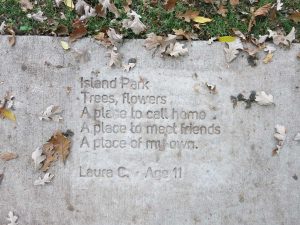
Stone plaque in Island Park in Fargo, North Dakota. A place to call home.
Home as where you belong can be elusive
A lot of sentiments about home have to do with feeling you belong somewhere – home is where the heart is, and so on. The very popularity of these sentiments, even though they may seem cliches, is a reflection of the widespread experiences behind them.
But it is not always easy to know where you belong, where home is. An excellent account of this existential uncertainty is Susan Armbrecht’s Thin Places: A Pilgrimage Home (2009). She is an anthropologist who spent her career studying Nepal. The last part of her book is about the difficulty she had adjusting when she returned to America. She writes: “I had travelled halfway around the world, all the way across my own country, looking for a place in the land to come home to. If only I found that place, I had thought, everything would fall into place. It was only in this year of moving from house to house that I came to realize – really realize – that home is not a place we ever reach. It is those moments – in time, not in space – where the wind cannot reach, the eddies and pools where things do not tremble. It is less a noun than a verb, an attitude and an action, living from the inside out…”
Women, home and oppression
Stephanie Taylor, in her book Narratives of Identity and Place (2010) pays considerable attention to the fact that home, as a Western ideal, is “inescapably associated with certain identities for women, as mothers, wives and homemakers,” yet is somewhere in which they do not have authority. Rowan Wilken describes home as a place of regressive nostalgia and a contested zone marked by gender differences, with role of housewife/homemaker role for women.
Feminists, such as Gillian Rose have adopted a stronger tone, noting that women are scarcely mentioned in discussions of place (she was writing in 1993 and I think this has been partially corrected; half the writers about home I cite here are women). She also notes that in the late 1970s feminists came to see the family and by implication the home as the major site of women’s oppression, so there seemed to be little reason to celebrate a sense of belonging to the home or to support the claim that the home provides the ultimate sense of place. All too often family violence creates places where people are housed but not at home, and basic needs for security and rest are violated.
Memory, collective memory, refugees and home
DylanTrigg in The Memory of Place (2012) begins his book with an account of a return to his childhood home and describes home as the locus of familiar personal memories. The geographer David Harvey in Justice, Nature and the Geography of Difference (1996) goes one step further when he refers to place as “the locus of collective memory”, and argues that place is somewhere with historical meanings that provide continuity across generations and define what can be considered home.
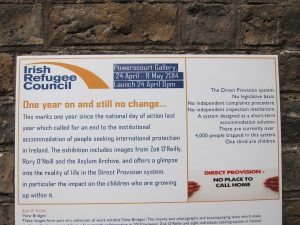
A sign in Dublin in 2014 advertising an exhibit to protest the way refugees were being accommodated. No place to call home.
In this latter collective sense the idea of finding a new home or the myth of return and going home can help to sustain people who are exiled or displaced. Those and a who have researched this, such as Johnathan Bascom in Losing Place: refugee populations in East Africa, 1998, have noted that the strength of the factors that tie people to a specific place, including familiarity, traditions and relatives, depreciate over time. In other words, the continuity of place memories is not constant.
Home region, homeland, exclusion
The idea of home place as being associated with collective memory is treated differently by. John Cameron in Changing Places: Re-Imagining Australia (2003), where he writes that loyalty to the earth can be achieved through developing loyalty and commitment to one’s home region. Loyalty to one’s region in this sense means personal affection for its landscapes and weather. Belonging to a region is also collectively apparent in being from somewhere with distinctive and familiar accents, dialects and customs. And regional loyalty is also apparent in a rather different way in the now widespread celebration of locally produced foods.
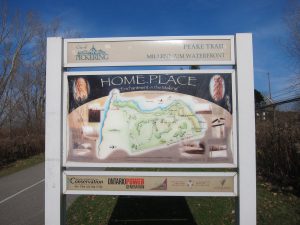
Home Place is an apparently imaginary somewhere. This sign is at the foot of a wind generator which is adjacent to a nuclear power station in Pickering, near Toronto. I can’t explain why it’s here.
Loyalty to home neighbourhood, town, region or homeland are spatial expansions of the experiences of belonging and security that are associated with one’s own house and home. This is fine when belonging involves an open and inclusive recognition of distinctiveness. But there is always the possibility that this can swing out of balance, become excessive and lead to exclusion, keeping others out because they are different and don’t belong. (I am writing this the day after the Brexit vote in the UK, which seems to have been partially informed by such attitudes, so this is an immediate and real possibility, not a theoretical one).
Protection of one’s home place from others might be considered a form of nimbyism, but exclusion of different others from home town, home region or homeland is at the very least a gesture towards possible fascism. I think it may well have been Heidegger’s philosophical enthusiasm for home region and homeland that led him to join the Nazi party (see his “Memorial Address” in Discourse on Thinking, published in 1959, where he still expresses dismay about the loss of rootedness and the fact that many Germans have lost their homeland or have wandered away and are now “strangers in their former homeland.”)
Homelessness in different senses
Roberto Dainotto in Place in literature: regions, cultures, communities (2000) cites a comment of Heidegger’s, who had observed a group of tourists in Greece: “Modern man feels at home anywhere.” This he relates to Heidegger’s idea of unheimlich (it doesn’t translate literally, but roughly it means homeless) as that which casts us out of the familiar and prevents us from making ourselves at home, and which recognizes the human tendency to make things unfamiliar through acts of violence against nature and against others. Dainotto suggests that that this means that every person is, in their essence and their nature without a place – we are un-heim. And without a home, we have to struggle constantly to try to build a home for ourselves.
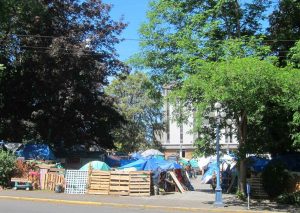
Tent City in Victoria, British Columbia in May 2016. This is an encampment of homeless people on small park next the Provincial court house, where the homeless have made a home for themselves.
This is the philosophical, existential sense of homelessness. The more immediate one, all too familiar in present day cities, is of those who have for various reasons fallen off the bottom rung of the socio-economic ladder and have no home. In a perverse way their presence, and the very idea of homelessness, are expressions of the fact that having a home is fundamental right in modern, generally affluent societies.
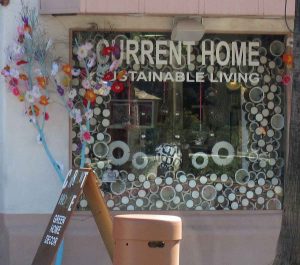
A store in Palm Springs that sells things for the sustainable home. A new mode of being at home.
New Modes of Being at Home
The intriguing idea of new modes of being at home is suggested in passing in S. Bergmann and T Sager (eds) The Ethics of Mobilities: Rethinking Place, Exclusion, Freedom and the Environment (2008). Others have discussed in some detail changes in experiences of home associated with mobility and telecommunications. Stephanie Taylor, for example, writes that: “The born and bred narrative is linked to a concept of home as based in long-term personal and family connections to a place. The ordinary mobility of contemporary Western societies mean that many people lack such a connection; they lack ‘easy identities’ in relation to place.” Rowan Wilken cites bell hooks: “Home is no longer just one place. It is locations” and raises the question of how place, community and teletechnology function in the highly personalized context of home. Do they modify conceptions of home, and what happens when conventional ideas are displaced by mobile technologies? Computers and other teletechnologies, he suggests, have been integrated into domestic life, including restructuring space in the home – they have been domesticated. At the same time mobile devices extend the boundaries of the home.
Lucy Lippard, whose book The Lure of the Local is largely about multicentred place experiences that have become common – living somewhere, developing an affection and association with it, then moving on and repeating the process – writes: “We are living today on a threshhold between a history of alienated displacement from and longing for home and the possibility of a multicentered society that understands the reciprocal relationship between the two.
* * * * * * * * * * * * * *
What I understand from these fragments of interpretations of home and place is that while born and bred narratives of home as somewhere secure and familiar, probably where you grew up or the family lives, endure as myths supported by some experiences, the broader reality is that home is malleable concept and it is undergoing radical transformations.
References
Armbrecht, A. 2009 Thin Places: A Pilgrimage Home, (Columbia University Press)
Bachelard, G. 1969 (1958) The Poetics of Space (Beacon Press)
Bascom, Johnathan, 1998 Losing Place: refugee populations and rural transformations in East Africa (Berghahn Books)
Bergmann, S., and Sager, T., (eds) 2008 The Ethics of Mobilities: Rethinking Place, Exclusion, Freedom and the Environment (Ashgate)
Cameron, John (ed) 2003 Changing Places: Re-Imagining Australia (Longueville Books)
Casey, Edward 2004 “Body, Self and Landscape: A Geophilosophical inquiry into the Place-World” in Adams, P., Till, K., Hoelscher, S. (eds) 2001 Textures of Place (University of Minnesota Press), pp. 403-420
Dainotto, Roberto 2000 Place in literature: regions, cultures, communities (Cornell University Press)
Donohue, Janet, 2012 “The Place of Home,” Environmental and Architectural Phenomenology Newsletter, Vol 23, 2, Spring 2012
Fried, Marc 2000 “Continuities and Discontinuities of Place” Journal of Environmental Psychology, 20, 193-205
Fullilove, Mindy, 2004 Rootshock: How Tearing Up City Neighborhoods Hurts America and What We Can Do About It, (Ballantine)
Harvey, D. 1996 Justice, Nature and the Geography of Difference (Blackwell)
Heidegger, M. 1966 Discourse on Thinking (Harper Torchbooks)
Lippard, Lucy 1997 The Lure of the Local: Senses of Place in a multi-centered society (W.W.Norton)
Malpas, Jeff 2000 Place and Experience: a philosophical topography (Cambridge University Press)
Manzo L. C., 2005 For better or worse: Exploring multiple dimension of place meaning Journal of Environmental Psychology 23 (1) 47-61
Moore, Jeanne, 2000 “Placing Home in Context” Journal of Environmental Psychology 20, 207-217
Relph, Edward 1976 Place and Placelessness (London: Pion)
Rose, Gillian, 1993 Feminism and Geography (University of Minnesota Press)
Sixsmith, Judith, 1986 “The Meaning of Home: An Exploratory Study of Environment Experience” Journal of Environmental Psychology 6 281-298
Taylor, Stephanie 2010 Narratives of identity and place (Routledge)
Trigg, Dylan, 2012 The memory of place: a phenomenology of the uncanny (Ohio University Press)
Tuan, Yi-Fu 1974 Topophilia: a study of environmental perception, attitudes and values (Prentice Hall)
Wilken, Rowan 2011 Teletechnologies, place, and community (Routledge)